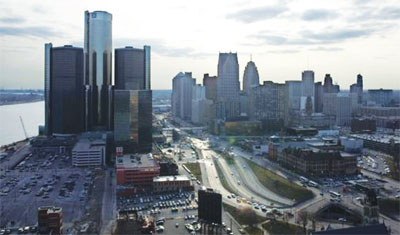
DETROIT (TIP): The city of Detroit filed for Chapter 9 bankruptcy protection in federal court Thursday, July 18, laying the groundwork for a historic effort to bail out a city that is sinking under billions of dollars in debt and decades of mismanagement, population flight and loss of tax revenue. The bankruptcy filing makes Detroit the largest city in U.S. history to do so.
The filing by a state-appointed emergency manager means that if the bankruptcy filing is approved, city assets could be liquidated to satisfy demands for payment. Kevin Orr, a bankruptcy expert, was hired by the state in March to lead Detroit out of a fiscal free-fall, and made the filing Thursday in federal bankruptcy court. “Only one feasible path offers a way out,” Gov. Rick Snyder said in a letter to Orr and state Treasurer Andy Dillon approving the bankruptcy. The letter was attached to the bankruptcy filing.
“The citizens of Detroit need and deserve a clear road out of the cycle of ever-decreasing services,” Snyder wrote. “The city’s creditors, as well as its many dedicated public servants, deserve to know what promises the city can and will keep. The only way to do those things is to radically restructure the city and allow it to reinvent itself without the burden of impossible obligations.”
Snyder had determined earlier this year that Detroit was in a financial emergency and without a plan to improve things. Snyder hired Orr in March, and he released a plan to restructure the city’s debt and obligations that would leave many creditors with much less than they are owed. Orr was unable to convince a host of creditors, including the city’s union and pension boards, to take pennies on the dollar to help facilitate the city’s massive financial restructuring.
Some creditors were asked to take about 10 cents on the dollar of what the city owed them. Under funded pension claims would have received less than 10 cents on the dollar under that plan. A team of financial experts put together by Orr said that proposal was Detroit’s one shot to permanently fix its fiscal problems.
The filing leads to a 30 to 90 day period that will determine whether or not the city of Detroit is eligible for Chapter 9 protection, and define the number of claimants who may compete for Detroit’s limited settlement resources. The petition seeks protection from unions and creditors who are renegotiating $18.5 billion in debt and liabilities, according to the Detroit Free Press.
“The President and members of the President’s senior team continue to closely monitor the situation in Detroit,” White House spokeswoman Amy Brundage said in a statement Thursday. “While leaders on the ground in Michigan and the city’s creditors understand that they must find a solution to Detroit’s serious financial challenge, we remain committed to continuing our strong partnership with Detroit as it works to recover and revitalize and maintain its status as one of America’s great cities,” the statement read. Sen.
Carl Levin, D-Mich., remained positive about Detroit’s outlook in spite of the major blow that bankruptcy delivered: “I know firsthand, because I live in Detroit, that our city is on the rebound in some key ways, and I know deep in my heart that the people of Detroit will face this latest challenge with the same determination that we have always shown,” the Senator said in a statement released Thursday.
A number of factors — most notably steep population and tax base falls — have been blamed on Detroit’s descent toward insolvency. Detroit was once synonymous with U.S. manufacturing prowess. Its automotive giants switched production to planes, tanks and munitions during World War II, earning the city the nickname “Arsenal of Democracy.” Detroit lost a quarter-million residents between 2000 and 2010.
A population that in the 1950s reached 1.8 million is struggling to stay above 700,000. Much of the middle-class and scores of businesses also have fled Detroit, taking their tax dollars with them. Detroit’s budget deficit is believed to be more than $380 million. Orr has said long-term debt was more than $14 billion and could be between $17 billion and $20 billion.
For decades, sizeable bankruptcies have been rare in the $3.7 trillion municipal bond market, but experts say there might be an uptick as counties, cities and towns wrestle with economic recession and stubbornly rising costs. Until Detroit filed its landmark case on Thursday, there had been four Chapter 9 municipal bankruptcy filings so far this year, compared with 12 in all of 2012 and 13 during 2011, according to James Spiotto, partner at Chapman and Cutler LLP. The four this year were special-purpose districts in Oklahoma and Arkansas.
The great bulk of Chapter 9 filings involve utilities and special districts, Spiotto said. Many cases are blocked by judges. Since 1954, cities, villages and counties accounted for only 61 Chapter 9 filings. The highest number of bankruptcy filings occurred in Nebraska, followed by California and Texas.
What will happen next
A bankruptcy judge will be appointed to oversee the city’s case. Hearings could take place in Detroit, Kentucky, Ohio or Tennessee. Chapter 9 bankruptcy is poorly understood, in part because it happens so infrequently. Detroit’s case is the largest in U.S. history. Here’s what happens next:
o The city filed a Chapter 9 bankruptcy petition Thursday in the U.S. Eastern District Court of Michigan.The filing includes additional information on the city’s financial outlook and could include details about the city’s plan to cut costs, such as potential layoffs and department consolidation, said Ken Schneider, a bankruptcy attorney with Detroit-based Schneider Miller PC.
o Alice Batchelder, chief judge of the U.S. 6th Circuit Court of Appeals, will appoint a bankruptcy judge to oversee the city’s case. o The bankruptcy judge will determine where to hold hearings, which could take place in Detroit, Kentucky, Ohio or Tennessee. o An automatic stay will be issued on most of Detroit’s bills, including unsecured debts, Schneider said today. The city will continue to pay secured creditors, including water and sewer bondholders, who have the right to seize city assets if Detroit fails to pay.
o An automatic stay also will be issued on lawsuits against the city, including outside challenges by pension officials and union members. This means hearings in those lawsuits will be indefinitely delayed. The plaintiffs can recast their arguments inside of bankruptcy court, said Jay Welford, a bankruptcy attorney and partner at Southfield-based Jaffe Raitt Heuer & Weiss.
o The city doesn’t need approval to continue services. For example, the police, fire, water, sewer and public works are completely unaffected by the bankruptcy filing for now and will operate as usual. However, cuts are possible in the future. “You have the ability to use your cash,” Welford said. “You don’t need court approval.”
o Creditors can challenge the city’s right to file for bankruptcy by issuing motions to dismiss the case. o In this case, bondholders and pension officials could accuse the city of failing to negotiate “in good faith,” one of the key criteria allowing the city to file for bankruptcy. The judge would hear arguments on this issue. A ruling could take days, weeks or months – perhaps even a year.
o The city also will have to prove it is insolvent, another stipulation required to file for Chapter 9 bankruptcy. According to the federal bankruptcy code, this requires the city to prove that it is not paying its bills. Emergency manager Kevyn Orr recently authorized the city to stop making payments on some debts. Bankruptcy experts believe that action was enough to satisfy the insolvency requirement, but creditors may still find wiggle room to argue the city is not insolvent.
o If the judge authorizes the city to move forward with a Chapter 9 bankruptcy case, Orr would propose a plan of reorganization. This could take weeks, months or years. Bankruptcy court allows the city to restructure its operations and its balance sheet. This could involve budget cuts, layoffs, consolidation, the sale of assets, slashing union contracts, selling assets and dramatically reducing city debts, including outstanding bonds.
o The city will attempt to win support for the reorganization plan from creditors, including secured bondholders, general obligation bondholders, unions and pension boards. If the city wins enough support, the plan would be put to a vote – and with enough support, the city could emerge from bankruptcy.
Without enough support, the judge could tell the city it must continue to negotiate with creditors. Orr may eventually pursue a “cram down” procedure, which would require winning support of a minority of creditors and convincing a judge that dissenting creditors are not being reasonable. “We’ll probably get to that because I don’t see how creditors are going to accept what he’s talking about paying them,” Schneider said.
o The length of the case is widely debated. Some experts believe it could be as short as several months. Others say it could take years. Most complex Chapter 9 cases have taken several years.
Recent and significant Chapter 9 cases include:
SAN BERNARDINO, CALIFORNIA
San Bernardino filed for bankruptcy status last August 1, becoming the third city in America’s most populous state during 2012 to use Chapter 9 in a fiscal crisis. The city of about 210,000 residents located 65 miles east of Los Angeles said it had more than $1 billion in debts and had tapped out its financial reserves. A federal bankruptcy judge has scheduled a hearing for August 28 to determine if the city is eligible for Chapter 9 shelter.
STOCKTON, CALIFORNIA
Stockton, a city of 300,000 located east of San Francisco, filed for bankruptcy in June 2012 and was until Detroit’s declaration the biggest U.S. city ever to seek Chapter 9 protection. After years of fiscal mismanagement and a housing market crash, Stockton was unable to pay workers, pensioners and bondholders. In April this year, a judge turned aside objections from bondholders trying to scuttle the case and cleared the way for Stockton to move ahead on a debt-adjustment plan, which local officials hope to file in September.
JEFFERSON COUNTY, ALABAMA
At $4.2 billion, Jefferson County set the previous record for the biggest U.S. municipal bankruptcy filing in November 2011. The county has since negotiated a tentative settlement with most creditors that still must be approved by a federal judge. The county, home to Birmingham, Alabama’s largest city, is weighed down by massive sewer-system debt. After the loss in 2011 of a local jobs tax that severely reduced revenues, the county cut 1,300 staff jobs, pulled back on government services and stopped payments on general obligation debt.
ORANGE COUNTY, CALIFORNIA
The county, California’s thirdmost populous, filed for bankruptcy in December 1994 after rising interest rates savaged investment bets by its treasurer, leaving the county with a loss of $1.7 billion in an investment pool. That put Orange County at risk of a $1 billion default the next year. Orange County emerged from bankruptcy after 18 months.
HARRISBURG, PENNSYLVANIA
Harrisburg, the state capital of Pennsylvania saddled with incinerator debts, lost a bid for Chapter 9 bankruptcy in 2011 and is now under state receivership. With a population of 50,000, Harrisburg is plagued by $320 million of debt incurred by cost overruns from an upgrade of its incinerator. In a bid to ease debts, the city is selling off thousands of Western and other historical artifacts accumulated by a former mayor to stock local museums that were never built.
VALLEJO, CALIFORNIA
Vallejo, a former U.S. Navy town near San Francisco, filed for bankruptcy on May 23, 2008, after failing to address steep city personnel costs and sliding revenue from a housing slump. In July 2011, the city won court approval for its financial plan to exit bankruptcy protection.
CENTRAL FALLS, RHODE ISLAND
The smallest city in the smallest U.S. state filed for bankruptcy on August 1, 2011, after failing to win concessions from public-sector retirees and others to address an $80 million unfunded pension and retiree health benefit liability, which was nearly quadruple its annual budget of $17 million. Central Falls last September won court approval of a reorganization plan that cut retiree pensions, raised taxes and left bondholders without losses.





Be the first to comment